

Microfinance and forest-based small-scale enterprises. 2005. FAO Forestry Paper No. 146. Rome, FAO. ISBN 0258-6150.

Communities around the world rely on forests for their livelihoods, not only for domestic uses but also for income, frequently obtained through small-scale, often family-run enterprises. The sustainable development of such enterprises is increasingly recognized as a key to poverty reduction but is often hindered by lack of financial inputs or poor access to microfinance services.
This book reviews the specific microfinance needs and challenges of small-scale forest-based enterprises, given that their activities are often seasonal and unpredictable. It analyses the constraints they face when trying to obtain microfinance services – including a lack of familiarity with formal financial institutions and insufficient capital or collateral for access to traditional banking services – and identifies ways to overcome these challenges.
The publication considers as small-scale enterprises those where economic activities are undertaken mainly at the individual or household level, usually employing members of the family, close relatives or neighbours, and where salaried labour is negligible. These are the forest enterprises that are most likely to face difficulties in accessing microfinance services. However, most of the issues and recommendations would also apply to larger enterprises, which may employ labourers.
The publication examines the role that different types of microfinance institutions, such as banks, non-governmental organizations, cooperatives and credit unions, can play for small-scale enterprises and forest communities. It discusses, in addition to microcredit, a comprehensive range of services including savings, group lending, leasing, insurance and cash transfers.
The strengths and weaknesses of different approaches are illustrated through four case studies:
Microfinance and forest-based small-scale enterprises will be a useful reference for those involved in designing policies and projects for the development of forestry communities, such as donors, government institutions and programme/project managers. It should also be of interest to institutions providing financial services to small enterprises in rural areas.
The publication is also available online: www.fao.org/docrep/008/a0226e/a0226e00.htm
Global Forest Resources Assessment 2005 – Progress towards sustainable forest management. 2006. FAO Forestry Paper No. 147. Rome, FAO. ISBN 92-5-105481-9.
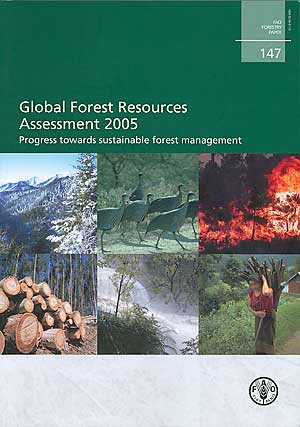
Humanity depends on the world’s forest resources to provide renewable raw materials and energy, maintain biological diversity, mitigate climate change, protect land and water resources, provide places for recreation, improve air quality and help alleviate poverty. At the same time, forests are affected by fire, air pollution, pests and invasive species, and are the primary targets in many countries for agricultural and urban expansion.
FAO has coordinated global forest resources assessments at five- to ten-year intervals since the Organization was established in 1945. The Global Forest Resources Assessment 2005 (FRA 2005) is the most comprehensive to date, both in terms of content and contributors. It covers far more than forest area, encompassing social, economic and environmental dimensions of forest resources. The data for FRA 2005 were delivered by national correspondents – nominated by the countries – and their networks of professionals. FAO coordinated the process and synthesized the information.
This publication – the main report of FRA 2005 – analyses the results to address the question “Is progress being made towards sustainable forest management?”. The answer is a mix of positive and negative signs. Intensive plantation forestry and conservation efforts are on the rise, while some primary forests continue to become degraded or converted to agriculture at alarming rates. The report also evidences a worrying correlation between negative forest resource trends and the state of rural poor populations, which calls for an intensified effort to understand and address the interrelationships of agriculture, forestry and poverty.
The report provides the quantitative country-by-country results of the assessment for 1990, 2000 and 2005, given in 20 global tables with regional and subregional subtotals (presented in Annex 3). Based on these country statistics, six core chapters evaluate the current status and trends, as well as the information availability, for six themes of sustainable forest management: extent of forest resources; biological diversity; forest health and vitality; protective functions of forest resources; productive functions of forest resources; and socio-economic functions. Chapter 8 synthesizes the key trends to illustrate progress towards sustainable forest management at the subregional, regional and global levels; a system of “traffic lights” indicates where there is cause for optimism and where there is cause for alarm.
Chapter 9 offers the main conclusions of the FRA 2005 process, including some considerations regarding future assessments. Annexes provide background material and terms and definitions in addition to the detailed country statistics.
The report is an essential reference for anyone interested in the status of the world’s forests. It will be indispensible for those involved in international negotiations related to forestry and for all concerned with the contribution of forestry to sustainable development.
The report is also available online: www.fao.org/docrep/008/a0400e/a0400e00.htm
Negotiation and mediation techniques for natural resource management. A. Engel & B. Korf. 2005. Rome, FAO.
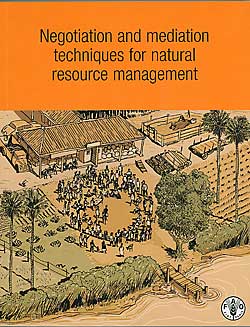
People have different uses for natural resources such as forests, water, pastures and land, and want to manage them in different ways. Knowing about the different needs and interests can help to inform successful management so that everyone benefits as much as possible. However, such differences can also lead to competition and conflict.
Negotiation and mediation techniques for natural resource management is a guidebook on how to deal with conflicts that can undermine or disrupt natural resource management, impede development and cause outbreaks of violence. It provides practical, step-by-step guidance on how to establish and manage a process of consensual negotiations involving multiple stakeholders, and how to integrate this process into the broad framework of collaborative natural resource management.
The guide was developed within the framework of FAO’s Livelihood Support Programme (LSP), which is funded by the United Kingdom’s Department for International Development (DFID). It builds on previously published FAO training material on community-based forest resource conflict management, revised based on the experiences of trainers, trainees and programme coordinators after almost two years of application in the field in Ghana.
The aims of conflict management are to:
The guide spells out the advantages and disadvantages of a range of conflict management approaches (e.g. customary, legal, alternative) to help practitioners assess which approach(es) may best suit a particular conflict situation. In particular, it focuses on conflict situations where a third party (mediator) is asked to assist in order that consensual negotiations can take place and work effectively. It acknowledges the cultural and social dimensions of different negotiation and mediation styles, to allow for flexible, situation-specific adaptation of the negotiation process for worldwide application.
The reader will find suggestions and recommendations for:
Two cases of successfully facilitated consensual negotiations in Ghana are presented in an annex.
The guide is intended for practitioners working on participatory or collaborative natural resource management and rural livelihood projects. It will be useful for extension workers, advisers of governmental and non-governmental organizations, development agencies and private companies who want to learn how to assist people in the process of consensual negotiations. It can provide valuable background to trainers preparing courses in natural resource conflict management, as well as to trainees.
The online version of the guide is available at: www.fao.org/docrep/008/a0032e/a0032e00.htm
Trends in wood products 1961–2003. 2005. Rome, FAO. ISBN 92-5-005377-0.
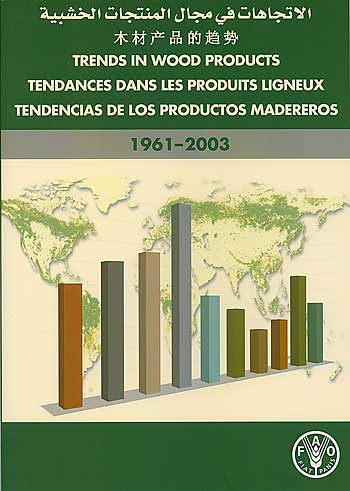
In many countries, production of wood and wood products is a significant source of employment and income to rural communities and of critical importance to national and local economies. For decades, FAO, in partnership with national and international institutions, has published detailed country statistics on forest products in the annual FAO Yearbook of Forest Products. The comprehensive statistics are also available online through FAOSTAT (faostat.fao.org). But the story told by the statistics is not always immediately apparent or easy to extract. This small, multilingual, user-friendly publication was created to provide a graphic overview of key global and regional trends in the domain of wood and wood products.
The publication begins with simple maps on the world’s forest resources (forest cover and wood volume in forests). The main sections summarize the production, trade and consumption of roundwood, woodfuel, industrial roundwood, sawnwood, veneer and plywood, reconstituted panels, pulp for paper, recovered paper, paper and paperboard, and all wood products (for roundwood and woodfuel, only production is depicted). The images include global maps of current status, tables listing leading countries, and graphics showing trends 1961–2003 by region and by product type. A final section on “forest sector in the economy” illustrates the contribution of the forest sector to gross domestic product, gross value added by the forest sector, share of wood products in global trade, and interregional flows in trade of wood products.
Headings and notes are in five languages – Arabic, Chinese, English, French and Spanish. Table and figure texts are in English, but translations of all terms used are provided in a multilingual glossary at the back of the book.
The publication will be of use to anyone seeking a quick summary at a glance of the role of wood products around the world and of how that role has evolved. It will be particularly helpful to readers seeking rapid insights without time-consuming number-crunching research.
The publication is also available online: www.fao.org/docrep/008/a0142m/a0142m00.htm
Legal and institutional aspects of urban and peri-urban forestry and greening. L. Knuth. 2005. FAO Legislative Studies No. 88. Rome, FAO. ISBN 92-5-105432-0.
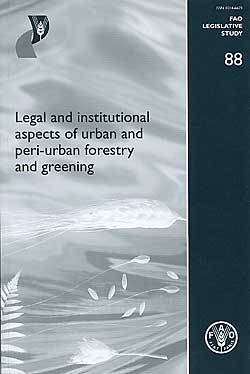
More than two-thirds of humanity will live in cities by 2050. Forests and trees in urban and peri-urban areas help ensure supplies of forest products, wood energy and clean water, provide recreational areas and help prevent and combat erosion, sand encroachment, floods and pollution, thus contributing to the improvement of livelihoods and the alleviation of poverty.
The policy and legal conditions for promoting forest and tree cover in urban environments, and the constraints on the use of and access to these resources, differ from those in rural areas. However, in general, urban and peri-urban forestry receives little attention on political agendas despite its important benefits for society. This is even more problematic in developing countries and countries with economies in transition, where urban development is too often accompanied by severe degradation of the environment (including trees and forests), increased poverty and food insecurity.
FAO has produced this publication to assist in building the capacities of national policy- and decision-makers and institutions to address legal, economic, social and environmental issues related to trees and forests in the urban environment. It gives an overview of the existing laws and regulations concerning urban and peri-urban forestry and greening, and points out issues that legislative bodies may have to consider in this regard. It is divided into six parts, including an introduction (Part 1), a conclusion (Part 6) and current definitions of urban and peri-urban forestry and greening (Part 2).
There is currently no international legal framework for urban and peri-urban forestry and greening. However, a number of international instruments – both soft law and legally binding – are applicable to it. These are described in Part 3. Most of these instruments address the subject obliquely rather than specifically, by addressing certain components (such as greening or open space) or related broad concepts (such as environment).
Part 4 deals with related national and subnational legal frameworks. With rare exceptions, urban and peri-urban forestry and greening is not comprehensively addressed in legislation at the country level, but many laws on forestry, the environment, land use planning, watershed protection and erosion control refer to or have an impact on it. At the municipal level, specific laws deal with the subject, such as those requiring permits for tree removals, providing for the protection of urban trees, or addressing negative effects of trees such as damage caused by growing roots to construction projects.
Finally, Part 5 analyses the institutional framework for urban and peri-urban forestry and greening using examples from different parts of the world, including Canada, China, the Philippines and South Africa.
The annexes provide additional information on existing legislation, useful Web sites and guidelines for surveys of national and municipal laws and regulations.
In providing a basic understanding of the overall legal framework at the national and subnational levels, this publication will be useful for those who are interested in developing an enabling policy-legal-institutional environment for urban and peri-urban forestry and greening in their countries.
Forest restoration in landscapes: beyond planting trees. S. Mansourian, D. Vallauri & N. Dudley, eds. 2005. New York, USA, Springer. ISBN 0-387-25525-7.
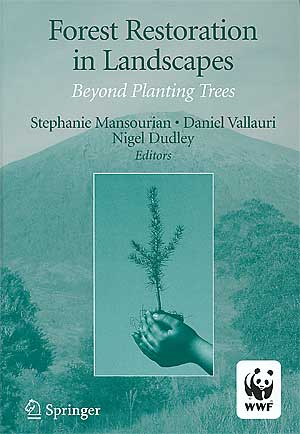
In an ideal world, restoration would not be necessary. However, today many forest habitats are so damaged that their long-term survival and the ecological services they provide are in doubt. Their restoration is urgent to sustain the livelihoods of people dependent on nature.
In response to these challenges, the World Wide Fund for Nature (WWF), working in collaboration with the World Conservation Union (IUCN) and other partners, is promoting a forest landscape restoration approach (see article on p. 40 of this issue), which aims to do much more than simply restore or increase forest cover. Forest landscape restoration brings people together to identify, negotiate and put in place practices that optimize the environmental, social and economic benefits of forests and trees within a broader pattern of land uses.
This practical handbook was developed to help provide guidance on how forest restoration can be integrated with other aspects of conservation and development in landscapes. It harnesses the expertise of over 70 authors drawing on a wealth of practical experience and a wide range of global expertise. Many of the contributors are leading academics or practitioners in the field. The publication is illustrated with numerous examples from all regions of the world.
Aimed at practitioners, researchers and decision-makers in the fields of development, conservation and beyond, Forest restoration in landscapes is intended to encourage field staff dealing with the impacts of forest loss and degradation to apply landscape-scale forest restoration to help meet their conservation goals.
The book is structured so as to take practitioners clearly through the different stages of the restoration process, but also to challenge them with unresolved issues. The first three parts introduce the elements for planning and implementing restoration within the broader landscape context. Subjects covered include mapping, modeling, targets, addressing challenges and constraints, conflict management, financing, and monitoring and evaluation of forest restoration projects.
The fourth part of the handbook provides guidance on specific aspects of forest restoration for particular objectives, for different forest types and in different circumstances or situations (e.g. following different types of disturbance).
The final part discusses some of the lessons learned to date from practical experiences and provides some recommendations for future work, including suggestions for further research, opportunities for collaboration and the needs for participation and institutional arrangements.